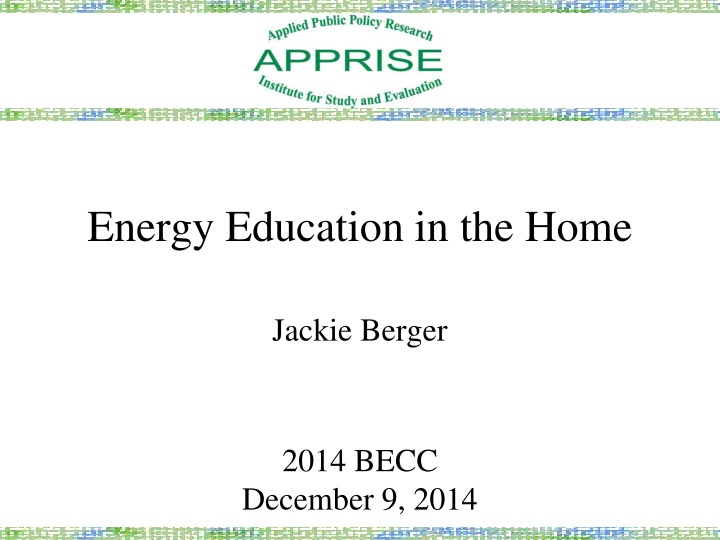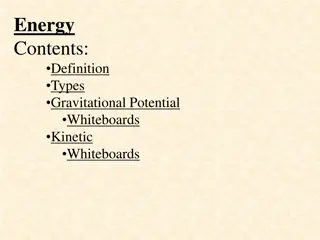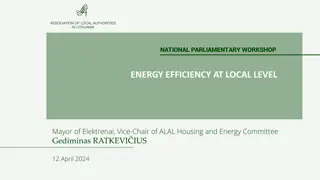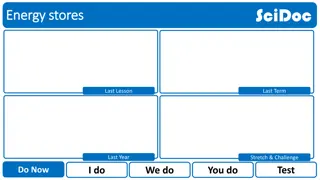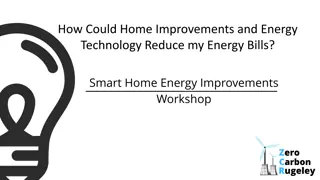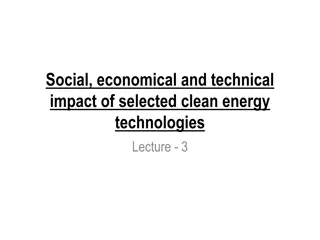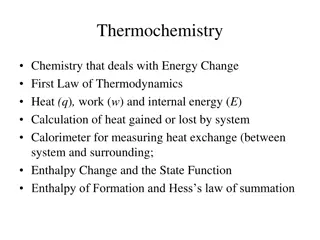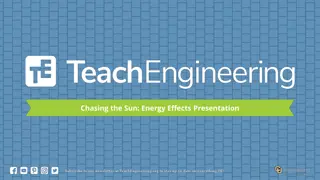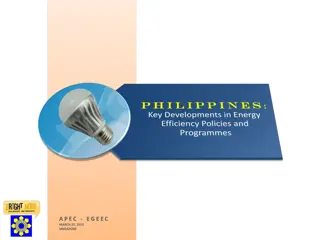Energy Education in the Home - Communication and Impact
Presentation on implementing energy education in low-income programs to achieve behavioral impacts and energy savings. Discusses assumptions, challenges in measurement, achieving impact, education procedures, and partnership for reducing energy usage.
Uploaded on Mar 11, 2025 | 0 Views
Download Presentation

Please find below an Image/Link to download the presentation.
The content on the website is provided AS IS for your information and personal use only. It may not be sold, licensed, or shared on other websites without obtaining consent from the author.If you encounter any issues during the download, it is possible that the publisher has removed the file from their server.
You are allowed to download the files provided on this website for personal or commercial use, subject to the condition that they are used lawfully. All files are the property of their respective owners.
The content on the website is provided AS IS for your information and personal use only. It may not be sold, licensed, or shared on other websites without obtaining consent from the author.
E N D
Presentation Transcript
Energy Education in the Home Jackie Berger 2014 BECC December 9, 2014
Communication with Participant 1. Understand what is happening in the home and inform implementation decisions 2. Ensure participant understands how to maximize benefits of measures 3. Develop partnership and achieve customer behavioral impacts Providers need to understand the importance of communication.
Presentation Overview Energy Education in Low-Income Programs Contractor Implementation (observations) Customer Reports (surveys) Energy Saving Impacts (billing analysis) Summary
Assumptions Behavioral changes can reduce energy usage We can identify the changes that will lower usage We can teach individuals how to change behavior We can motivate individuals to change behavior
Measurement Challenge How do we attribute savings to education? No random assignment All customers receive education Education protocols are program wide Variations in contractor performance Relationship to customer reports (surveys) Relationship to usage impacts (billing analysis)
Achieving Impact 1. Are the in-home education procedures implemented by contractors? 2. Do customers internalize and act on this information? 3. Does the education translate into energy savings?
Education Process Partnership between program/educator and customer If successful, customer has more motivation to take steps to reduce energy usage Understanding the energy bills If the customer understands how to read the bill and determine when usage is decreasing, it provides positive re-enforcement for energy-saving actions Energy use and costs around the home Allows customer to make decisions about energy usage based on the costs of those uses
Education Process Customer goals for usage reduction Customer action plan Provides motivation for customer to reduce energy usage Provides direction for customer Follow-up See how savings plan is working Positive reinforcement Adjust goals or set additional goals
CONTRACTOR IMPLEMENTATION Are in-home education procedures implemented by contractors?
Audit Observation Findings Program 1 Program 2 Discussion Home Comfort Energy Issues 94% 49% 59% 34% Energy Bill Review with Customer 38% 12% Home Walk Through Discussed Usage Discussed Actions 62% 75% 36% 21% Action Plan Recommended actions w/savings potential Obtained customer commitment 67% 22% 11% 7% Implementation varies widely by program.
Audit Observation Findings Contractor 2 # Obs 15 13 12 9 15 15 15 Contractor Discussed 1 % Taken 63% 72% 72% 35% 91% 42% 55% 3 # Obs 32 32 32 31 32 31 31 % Taken 47% 54% 42% 11% 73% 60% 60% # Obs 22 22 22 22 22 22 22 % Taken 68% 91% 59% 91% 64% 82% 95% Energy Usage Energy Saving Actions Heat Setback Cooling Usage Reduction Lighting Use Actions with Greatest Potential Summary of Action Opportunities Implementation varies by contractor within a program.
CUSTOMER ACTIONS Do customers internalize and act on this information?
Customer Response Energy Bill Review Contractor 1 459 43% Contractor 2 194 24% Contractor 3 203 35% Survey Respondents Provider Reviewed Bills Provider Explained How Energy Use is Measured Customer has Good Understanding of Energy Bill 50% 40% 50% 81% 74% 79% 15
Customer Response Action Plan Contractor 1 459 Contractor 2 194 Contractor 3 203 Survey Respondents Provider Gave Written Action Plan Customer Agreed to Take Actions Provider Estimated Monetary Savings from Actions 58% 44% 58% 55% 41% 54% 27% 18% 32%
Customer Response Usage Reduction Actions Contractor 1 459 Contractor 2 194 Contractor 3 203 Survey Respondents Customer Implemented Energy Saving Actions Customer Reduced Heating Usage Customer Reduced Hot Water Usage Customer Reduced Air Conditioning Usage 64% 56% 60% 48% 40% 51% 38% 32% 41% 42% 31% 38%
ENERGY SAVING IMPACTS Does education result in reduced energy usage?
Energy Usage Impacts Contractor 1 Contractor 2 Contractor 3 Electric Baseload Observations Pre-Usage (kWh) % Saved Electric Heating Observations Pre-Usage (kWh) 2,106 7,219 6.8% 523 7,762 3.1% 408 7,444 3.2% 200 13,518 6.5% 68 54 13,030 5.5% 13,428 5.6% % Saved Gas Heating Observations Pre-Usage (ccf) % Saved 2,024 1,009 2.9% 479 1,095 4.1% 436 979 7.3%
Connections Observations: Contractors 1&3 More likely to discuss usage and actions Customer Survey: Customers of Contractors 1&3 More likely to report bill was reviewed More likely to report action plan More likely to report reduced usage Energy Savings - Billing Analysis: Customers of Contractor 1 highest electric baseload Customers of Contractor 3 highest gas heating
Summary Good procedures have been developed The challenge is implementation Providers must be trained and compensated Quality control and assessment is needed Can impact savings and cost-effectiveness
